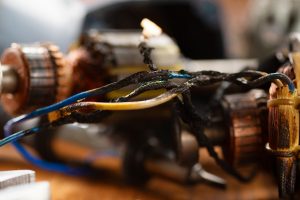Safety 1st: Preventing Electrical Fires to Keep Your Family Safe
It is sad to say that regular safety checks that can prevent electrical fires are done far too infrequently. This is often due to people being ill-informed or becoming complacent – “it will never happen to me.” Fires caused by electricity, such as because of faulty wiring can be devasting. Not only can homes be lost but so can lives. Prevention is paramount. The unfortunate thing is electrical items deteriorate over time. This is why it is critical to have regular testing of the electrical equipment protecting your house. Learning the common causes of fires and how you can go about preventing them are the first steps to protecting your family.
Fires Caused By Electricity Account For Almost 40% of house fires in NSW Homes
Faulty wiring and outdated electrical components in Australian homes are too common. The pictures at the top of this article are from jobs where we have undertaken safety checks. The clients were completely unaware of the dangers and thought their house was safe. After uncovering some extremely unsafe conditions they were prompted to upgrade switchboards and rewire.
The scariest thing about these situations was that these electrical items were in full operation providing electricity to their home. Almost 40% of NSW homes in this very situation have had to call emergency services to attend their home for a fire(*1). It is very concerning to think there are a lot of homes still out there with these conditions.
Every year, NSW firefighters attend around 1800 residential fires caused by faulty wiring or electrical faults(*1).
Preventing Electrical Fires

The most sure-fire ways to prevent an electrical fire is to:
- Only work with licensed electricians – check your electrician is certified here.
- Have your home regularly inspected.
- Avoid overloading power points and power boards.
- Keep electrical components, cords and devices dry and away from moisture.
- Stay up-to-date on electrical appliance and device recalls.
Electrical Installation Safety

There are many elements to an electrical installation that make up a completely safe environment. The breakdown of these elements is what causes risks. At Lightspeed Electrical we have developed a safety checklist that incorporates Australian standards. Your safety and the safety of our team are the most important aspects of our job. We use the latest testing equipment to undertake tests and give our clients reports on each of the elements in the installation. The tests indicate either a pass or fail which we then use to bring everything up to Australian safety standards.
New Australian Legislation for Electrical Wiring (Wiring Rules)
With approximately 30% of fatalities in NSW caused by preventable house fires, the release of this legislation for wiring was essential(*2,3). The new legislation came into effect on January 1st, 2019(*3). It is now mandatory for all circuits in a domestic setting of 32amps and under to have a residual current device (RCD) safety switch.
I believe this should have been implemented years ago. RCDs save lives and it makes sense to have them on every circuit in the house.
• Alex Schepis (Lightspeed Electrical owner and licensed residential, commercial, and industrial electrician).
An Extra Layer of Prevention (and Safety): Arc Fault Detection Devices
Of the many new rules introduced, a very interesting one was the introduction of AFDDs (arc fault detection devices). AFDDs had been around for a while although, before the new legislation, they were not readily available in Australia.
What do AFFDs do?
An AFDD adds an additional level of safety to prevent fires from starting from arcing. An example of arcing is when you switch a light switch on and off and there is a crackling sound. This is an arc and is a tell-tale sign that there is a breakdown in the switch somewhere.
Arcing can happen for several reasons including(*4):
• Loose connections.
• Faulty equipment.
• Deterioration of materials over time.
• Accidental damage to leads and plugs e.g., being squashed or trapped.
• Mistreated appliance cables e.g., plugs that are pulled by the cable and not the plug top.
How do AFDDs Work?
Arcs produce heat from bad connections known as ‘hot joints’ and this is what causes fires. AFDD’s detect this arc and automatically switches the circuit off to prevent the continuation of electricity that produces the build-up of heat(*4).
Whilst not yet mandatory, AFFD’s are relatively cheap to have installed in the context of a home. That is not to mention the safety level these bring to your loved ones by identifying faulty materials and preventing fires.
If you would like us to provide you with our specialised safety check, feel free to contact us on 1300 968 551 or via our contact page.
References *1. NSW Fire and Rescue. Common Home Fires. 2021. *2. Coates, L, Kaandorp, G, Harris, J, Van Leeuwen, J, Avci, A, Evans, J, George, S, Gissing, A, Van den Honert, R & Haynes, K. Preventable Residential Fire Fatalities in Australia July 2003 to June 2017. Bushfire and Natural Hazards CRC. Report No. 506. 2019. *3. NSW Fair Trading. Electrical Standards, Rules and Notes. NSW Government. 2021. *4. Clipsal. ArcFault Detection Device. Schneider Electric Australia Pty Ltd. 2021.


